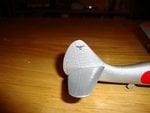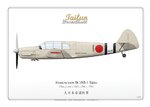Navigation
Install the app
How to install the app on iOS
Follow along with the video below to see how to install our site as a web app on your home screen.
Note: This feature may not be available in some browsers.
More options
You are using an out of date browser. It may not display this or other websites correctly.
You should upgrade or use an alternative browser.
You should upgrade or use an alternative browser.
Foreign Aircraft in Japanese Markings
- Thread starter syscom3
- Start date
Ad: This forum contains affiliate links to products on Amazon and eBay. More information in Terms and rules
More options
Who Replied?HI all,
Sorry to bring back to life a old thread.
Anyway, I am having some very interesting discussions about whether Japan every received two He-119 aircraft for evaluation?
There are some conflicting reports and it appears that Japan did order and pay for them and they were supposedly shipped in May1940 but other than some authors saying they arrived (William Green and David Donald as well as a Arawasi article by Paul Starking) and others no evidence.
See here:
Exports to Japan - Page 3 - Luftwaffe and Allied Air Forces Discussion Forum
here:
Heinkel He119 - was it used by the Luftwaffe? - Luftwaffe Experten Message Board
and here:
Japanese He-119 Torpedo Bomber
I am interested to know if anyone here has further details on this mystery?
Also DerAdlerIstGelandet list does NOT have this plane on it, (could you have another look?) but it does appear on some other lists!
regards
Peter H
Sorry to bring back to life a old thread.
Anyway, I am having some very interesting discussions about whether Japan every received two He-119 aircraft for evaluation?
There are some conflicting reports and it appears that Japan did order and pay for them and they were supposedly shipped in May1940 but other than some authors saying they arrived (William Green and David Donald as well as a Arawasi article by Paul Starking) and others no evidence.
See here:
Exports to Japan - Page 3 - Luftwaffe and Allied Air Forces Discussion Forum
here:
Heinkel He119 - was it used by the Luftwaffe? - Luftwaffe Experten Message Board
and here:
Japanese He-119 Torpedo Bomber
I am interested to know if anyone here has further details on this mystery?
Also DerAdlerIstGelandet list does NOT have this plane on it, (could you have another look?) but it does appear on some other lists!
regards
Peter H
proton45
Senior Airman
I believe that the captured Allied aircraft were the only aircraft opened to public in wartime Japan. Technical matters on these planes were discussed by the Army test pilots and engineers as well as the civillians on an article in the same issue of the Koku Asahi magazine.
In that, according to my vague memory, one of the Army officers mentioned there were many people including pilots rushed to fly the captured B-17s and that annoyed him. They admitted the bomber was a good and easy airplane to fly in. In that respect the Army officers participated in the discussion seemed to be fair and honest.
In that, according to my vague memory, one of the Army officers mentioned there were many people including pilots rushed to fly the captured B-17s and that annoyed him. They admitted the bomber was a good and easy airplane to fly in. In that respect the Army officers participated in the discussion seemed to be fair and honest.
Last edited:
otftch
Staff Sergeant
I think the profiles are coming from the magazine "Avions" - Lela Presse, probably old #, the signature under each of them is "MM" for Michel Martraix, an illustrator working for this publication.
Here are some other from same source, le last one, Fairchield is not a captured plane, but on the top of the tail fin the logo looks like the Lufwaffe badge !?
Does anybody have information or closer view of the tail of this Fairchild ?
Thank you.
I'm pretty sure that is the fairchild logo.
Ed
Bullo Loris
Senior Airman
- 334
- Oct 14, 2006
I think the profiles are coming from the magazine "Avions" - Lela Presse, probably old #, the signature under each of them is "MM" for Michel Martraix, an illustrator working for this publication.
Here are some other from same source, le last one, Fairchield is not a captured plane, but on the top of the tail fin the logo looks like the Lufwaffe badge !?


Does anybody have information or closer view of the tail of this Fairchild ?
Thank you.
Where you get from?, really good post...
I found some of them. First one is with a Ki-61 flying with a Bf-109. Second to last one is the Bf-108. Last one is the Ju-87
The top photo is also interesting because the Japanese fighter flying with the 109 appears to be a Ki-60, NOT a Ki-61. Note the long glazed area behind the cockpit.
otftch
Staff Sergeant
Tail Markings on Fairchild 91.This might help.I won't re-size so you can see detail.Where you get from?, really good post...
Ed
Attachments
Last edited:
I think the Germans were interested in the "Dinah" as a high speed photo recon plane.
I dont know if any were sent to Germany for evaluation.
At least this is reported in several older William Green books. Supposedly would have been license built but negotiations fell through. No evidence any were actually in Germany, though.
Really interesting thread and great pics. Thanks to all.
Running through it is an idea of the Japanese as copiers of pre ww2 western aircraft development. I don't think this is entirely true.
Search 'Fred David Heinkel' for an incredible story. Worked for Heinkel, Jewish, Ernst Heinkel got him out of Germany by sending him to Japan where he was adapting Heinkel designs for the Japanese. Things turned bad there eventually and he fled. Long story ends with him pulled out of a camp to join the Australians who designed and built the Boomerang.
The Japanese weren't copying....they were involved in an intense process of adaption and development with some of the best of European aircraft design. Little wonder their aircraft were so good.....
Running through it is an idea of the Japanese as copiers of pre ww2 western aircraft development. I don't think this is entirely true.
Search 'Fred David Heinkel' for an incredible story. Worked for Heinkel, Jewish, Ernst Heinkel got him out of Germany by sending him to Japan where he was adapting Heinkel designs for the Japanese. Things turned bad there eventually and he fled. Long story ends with him pulled out of a camp to join the Australians who designed and built the Boomerang.
The Japanese weren't copying....they were involved in an intense process of adaption and development with some of the best of European aircraft design. Little wonder their aircraft were so good.....
japsubshunter
Airman
- 14
- Dec 7, 2013
Bf109E-7, Japan, 1941 Five Bf109s were sent to Japan, sans armament, for evaluation. While in Japan they received the standard Japanese hinomarus and yellow wing leading edges, as well as white numerals on the rudder. A red band outlined in white is around the rear fuselage. Study of the Bf109 in Japan led to the design of the formidable Ki-61 Hein.
The colors of the plane appear to be the standard RLM 74/75/76 scheme, with medium mottling on the fuselage sides, probably including both RLM 74 and RLM 75 as well as RLM 02. It is possible that some or all of these planes were later repainted in standard IJAAF colors.
Caption and Drawing by Chris Banyai-Riepl from his upcoming book on the 109.
Attachments
japsubshunter
Airman
- 14
- Dec 7, 2013
Nice pics have found one more color image.
japsubshunter
Airman
- 14
- Dec 7, 2013
I found some of them. First one is with a Ki-61 flying with a Bf-109. Second to last one is the Bf-108. Last one is the Ju-87
I have quite a nice pic of the Ju.87 ''Stuka'' on display in Japan during the war.
Last edited by a moderator:
japsubshunter
Airman
- 14
- Dec 7, 2013
I found some of them. First one is with a Ki-61 flying with a Bf-109. Second to last one is the Bf-108. Last one is the Ju-87
Attachments
japsubshunter
Airman
- 14
- Dec 7, 2013
JAPAN (and Manchukuo Air Lines):
Manchukuo National Airways was established on 1931-09-26 in Fengtian by order of the Japanese Kwantung Army, out of the Manchurian branch office of Japan Air Transport, the forerunner of Imperial Japanese Airways. It officially adopted the name Manchukuo National Airways on the proclamation of the independence of the Japanese puppet state of Manchukuo.
From the beginning, the Manchukuo National Airways was a paramilitary airline, whose primary purpose was to provide transport and logistical support for the military, and for the transport of mail. Civilian passengers were carried and charter operations undertaken on a lower priority.
The airline had a total of 15 Bf 108s in its inventory. The Manchukuo National Airways ceased operations in August 1945 during the Soviet invasion of Manchuria.
Manchukuo National Airways was established on 1931-09-26 in Fengtian by order of the Japanese Kwantung Army, out of the Manchurian branch office of Japan Air Transport, the forerunner of Imperial Japanese Airways. It officially adopted the name Manchukuo National Airways on the proclamation of the independence of the Japanese puppet state of Manchukuo.
From the beginning, the Manchukuo National Airways was a paramilitary airline, whose primary purpose was to provide transport and logistical support for the military, and for the transport of mail. Civilian passengers were carried and charter operations undertaken on a lower priority.
The airline had a total of 15 Bf 108s in its inventory. The Manchukuo National Airways ceased operations in August 1945 during the Soviet invasion of Manchuria.
Users who are viewing this thread
Total: 1 (members: 0, guests: 1)
Similar threads
- Replies
- 3
- Views
- 304




![MeBf.108b [Taifun] camo.jpg](/forum/data/attachments/539/539923-3a8f7350a5da0b709a8f61719794e11e.jpg)
